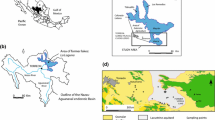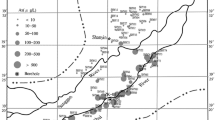Abstract
The Hetao Plain, located in western Inner Mongolia, China, has been used for irrigation since the second century BC. Sixty-five samples were collected, including fifty-nine groundwater and six surface water samples, for hydrochemical and oxygen and hydrogen stable isotope analysis to assess the impact of irrigation on arsenic mobilization in groundwater in the study area. The total dissolved arsenic concentration in groundwater and surface water ranged from 3.2 to 764.8 μg/L and from 6.2 to 11.2 μg/L, respectively, generally exceeding 50 μg/L in groundwater, where the reducing environment prevails. The primary groundwater recharge source was a shallow aquifer that receives a considerable amount of irrigation water. The high arsenic content in groundwater was attributed to hydrochemical processes caused by vertical leaching of dissolved halite from the unsaturated zone, which was determined based on the molar Cl/Br ratios analysis. The oxygen and hydrogen stable isotope analysis of groundwater demonstrated the mixing between the groundwater and Yellow River water. An association between lateral recharge and mixing, evaporation, leaching, vertical mixing, and arsenic enrichment in groundwater was established based on the correlation between Cl– concentration and δ18O values. In an anaerobic groundwater environment, nitrate from nitrogen fertilizers indirectly oxidized As(III) to As(V).











Similar content being viewed by others
REFERENCES
S. Adams, R. Titus, K. Pietersen, G. Tredoux, and C. Harris, “Hydrochemical characteristics of aquifers near Sutherland in the Western Karoo, South Africa,” J. Hydrol. 241, 91–103 (2001).
S. Ahamed, M. K. Sengupta, A. Mukherjee, M. A. Hossain, B. Das, B. Nayak, A. Pal, S. C. Mukhejee, S. Pati, R. N. Dutta, G. Chattejee, A. Mukhejee, R. Srivastava, and D. Chakraborti, “Arsenic groundwater contamination and its health effects in the state of Uttar Pradesh (UP) in upper and middle Ganga plain, India: A severe danger,” Sci. Total Environ. 370, 310–322 (2006).
F. J. Alcalá, and E. Custodio, “Using the Cl/Br ratio as a tracer to identify the origin of salinity in aquifers in Spain and Portugal,” J. Hydrol. 359, 189–207 (2008).
M. W. Busbee, B. D. Kocar, and S. G. Benner, “Irrigation produces elevated arsenic in the underlying groundwater of a semi-arid basin in Southwestern Idaho,” Appl. Geochem. 24, 843–859 (2009).
I. Cartwright, T. R. Weaver, and L. K. Fifield, “Cl/Br ratios and environmental isotopes as indicators of recharge variability and groundwater flow: An example from the southeast Murray Basin, Australia,” Chem. Geol. 231, 38–56 (2006).
H. Craig, “Isotope variation in meteoric waters,” Science 133, 1702–1703 (1961).
S. N. Davis, D. O. Whittemor, and J. Fabryba-Martin, “Uses of chloride/bromide ratios in studies of potable water,” Ground Water 36, 338–350 (1998).
Y. Deng, Y. Wang, and T. Ma, “Isotope and minor element geochemistry of high arsenic groundwater from Hangjinhouqi, the Hetao Plain, Inner Mongolia,” Appl. Geochem. 24, 587–599 (2009a).
Y. Deng, Y. Wang, T. Ma, and Y. Gan, “Speciation and enrichment of arsenic in strongly reducing shallow aquifers at western Hetao Plain, northern China,” Environ. Geol. 56, 1467–1477 (2009b).
J. R. Gat, “Oxygen and hydrogen isotopes in the hydrologic cycle,” Amu. Rev. Earth Planet. Sci. 24, 225–262 (1996).
H. Guo, B. Zhang, Y. Li, Z. Berner, X. Tang, S. Norra, and D. Stuben, “Hydrogeological and biogeochemical constrains of arsenic mobilization in shallow aquifers from the Hetao basin, Inner Mongolia,” Environ. Pollut. 159, 876–883 (2011).
H. Guo, S. Yang, X. Tang, Y. Li, and Z. Shen, “Groundwater geochemistry and its implications for arsenic mobilization in shallow aquifers of the Hetao Basin, Inner Mongolia,” Sci. Total Environ. 393, 131–144 (2008).
Q. H. Guo, Y. X. Wang, X. B. Gao,and T. Ma, “A new model (DRARCH) for assessing groundwater vulnerability to arsenic contamination at basin scale: a case study in Taiyuan basin, northern China,” Environ. Geol. 52, 923–932 (2007).
H. M. Guo, D. G. Wen, Z. Y. Liu, Y. F. Jia, and Q. Guo, “A review of high arsenic groundwater in Mainland and Taiwan, China: Distribution, characteristics and geochemical processes,” Appl. Geochem. 41, 196–217 (2014).
C. F. Harvey, K. N. Ashfaque, W. Yu, A. B. M. Badruzzaman, M. A. Ali, P. M. Oates, H. A. Michael, R. B. Neumann, R. Beckie, S. Islam, and M. F. Ahmed, “Groundwater dynamics and arsenic contamination in Bangladesh,” Chem. Geol. 228, 112–136 (2006).
W. Kloppmann, P. N’egrel, and J. Casanova, “Halite dissolution derived brines in the vicinity of a Permian salt dome (N German Basin). Evidence from boron, strontium, oxygen, and hydrogen isotopes,” Geochim. Cosmochim. Acta 65, 4087–4101 (2001).
H. W. Langner, C. R. Jackson, T. R. McDermott, and W. P. Inskeep, “Rapid oxidation of arsenite in a hot spring ecosystem, Yellowstone National Park,” Environ. Sci. Technol. 35, 3302–3309 (2001).
M. I. Leybourne, and E. M. Cameron, “Source, transport, and fate of rhenium, selenium, molybdenum, arsenic, and copper in groundwater associated with porphyry-Cu deposits, Atacama Desert, Chile, ” Chem. Geol. 247, 208–228 (2008).
F. Li, X. Song, C. Tang, C. Liu, J. Yu, and W. Zhang, “Tracing infiltration and recharge using stable isotope in Taihang Mt., North China,” Environ. Geol. 53, 687–696 (2007).
P. Li, B. Li, G. Webster, Y. H. Wang, D. W. Jiang, X. Y. Dai, Z. Jiang, H. L. Dong, and Y. X. Wang, “Abundance and Diversity of Sulfate-Reducing Bacteria in High Arsenic Shallow Aquifers,” Geomicrobiol. J. 31, 802–812 (2014).
J. M. McArthur, D. M. Banerjee, K. A. Hudson-Edwards, R. Mishra, R. Purohit, P. Ravenscroft, A. Cronin, R. J. Howarth, A. Chatterjee, T. Talukder, D. Lowry, S. Houghton, and D. K. Chadha, “Natural organic matter in sedimentary basins and its relation to arsenic in anoxic ground water: the example of West Bengal and its worldwide implications,” Appl. Geochem. 19, 1255–1293 (2004).
R. Nativ, E. Adar, O. Dahan, and M. Geyh, “Water recharge and solute transport through the vadose zone of fractured chalk under desert conditions,” Water Resources Res. 31, 253–261 (1995).
H. Neidhardt, S. Norra, X. Tang, H. Guo, and D. Stuben, “Impact of irrigation with high arsenic burdened groundwater on the soil-plant system: Results from a case study in the Inner Mongolia, China,” Environ. Pollut. 163, 8–13 (2012).
R. B. Neumann, K. N. Ashfaque, A. B. M. Badruzzaman, M. A. Ali, J. K. Shoemaker, and C. F. Harvey, “Anthropogenic influences on groundwater arsenic concentrations in Bangladesh,” Nat. Geo Sci. 3, 46–52 (2010).
R. Nickson, J. McArthur, W. Burgess, K. M. Ahmed, P. Ravenscroft, and M. Rahman, “Arsenic poisoning of Bangladesh groundwater,” Nature 395, 338–338 (1998).
D. Postma, F. Larsen, N. T. Thai, T. K. T. Pham, R. Jakobsen, P. Q. Nhan, T. V. Long, P. H. Viet, and A. S. Murray, “Groundwater arsenic concentrations in Vietnam controlled by sediment age,” Nat Geo Sci. 5, 656–661 (2012).
D. Postma, and C. Boesen, “Nitrate reduction in an unconfined sandy aquifer: water chemistry, reduction processes, and geochemical modeling,” Water Resources Res. 27, 2027–2045 (1991).
L. Rodriguez-Lado, G. F. Sun, M. Berg, Q. Zhang, H. B. Xue, Q. M. Zheng, and C. A. Johnson, “Groundwater arsenic contamination throughout China,” Sci. 341, 866–868 (2013).
D. B. Senn, and H. F. Hemond, “Nitrate controls on iron and arsenic in an urban lake,” Science 296, 2373–2376 (2002).
P. L. Smedley, and D.G. Kinniburgh, “A review of the source, behaviour and distribution of arsenic in natural waters,” Appl. Geochem. 17 (5), 517–568 (2002).
J. Tong, H. Guo, and C. Wei, “Arsenic contamination of the soil-wheat system irrigated with high arsenic groundwater in the Hetao Basin, Inner Mongolia, China,” Sci. Total Environ. 496, 479–487 (2014).
M. Tsujimura, Y. Abe, T. Tanaka, J. Shimada, S. Higuchi, T. Yamanaka, G. Davaa, and D. Oyunbaatar, “Stable isotopic and geochemical characteristics of groundwater in Kherlen River basin, a semi-arid region in eastern Mongolia,” J. Hydrol. 333, 47–57 (2007).
X. Wang, Z. Huo, P. Guo, Z. Qu, “Drip irrigation enhances shallow groundwater contribution to crop water consumption in an arid area,” Hydrol. Process 32, 747–758 (2018).
J. Wurl, L. Mendez-Rodriguez, and B. Acosta-Vargas, “Arsenic content in groundwater from the southern part of the San Antonio-El Triunfo mining district, Baja California Sur, Mexico,” J. Hydrol. 518, 447–459 (2014).
X. J. Xie, Y. X. Wang, A. Ellis, C. X. Liu, M. Y. Duan, and J. X. Li, “Impact of sedimentary provenance and weathering on arsenic distribution in aquifers of the Datong basin, China: Constraints from elemental geochemistry,” J. Hydrol. 519, 3541–3549 (2014).
X. J. Xie, Y. X. Wang, C. L. Su, J. X. Li, and M. D. Li, “Influence of irrigation practices on arsenic mobilization: Evidence from isotope composition and Cl/Br ratios in groundwater from Datong Basin, northern China,” J. Hydrol. 424–425, 37–47 (2012).
A Y. Zeng, F. H. Hao, J. X. Zhang, W. Ouyang, M. X. Zhang, “Analysis of spatiotemporal distribution characteristics of soil nitrogen in different irrigation seasons in Hetao irrigation area,” J. Environ. Sci. 05, 845–852 (2008).
J F. Zhang, Y. Zhu, X. Zhang, M. Ye, J. Yang, “Developing a Long Short-Term Memory (LSTM) based model for predicting water table depth in agricultural areas,” J. Hydrol. 561, 918–929 (2018).
T. X. Zhao, Y. Zhu, Y. Zhu, M. Ye, B. Jia, W. Mao, “A new approach for estimating spatial-temporal phreatic evapotranspiration at a regional scale using NDVI and water table depth measurements,” Agric. Water Manag. 264, 107500 (2022).
ACKNOWLEDGMENTS
Thanks go to Zhenlong Li, Zhen Di, and Wei Song at the Centers for Disease Control and Prevention of Hangjinhouqi County for their support for sample collection. The authors thank professors Hongyin Han and Yiqun Gan for their help with sample measurements. We appreciate the Associated Editor Dr. E.S. Sidkina and two anonymous reviewers’ constructive suggestion and comments on this manuscript.
Funding
This project was funded jointly by the Open Fund of Jiangxi Provincial Key Laboratory of Water Resources and Environment of Poyang Lake (2022SKSH03), and Open Funding Project of the Key Laboratory of Groundwater Sciences and Engineering, Ministry of Natural Resources (SK202301-2).
Author information
Authors and Affiliations
Corresponding author
Ethics declarations
The authors of this work declare that they have no conflicts of interest.
Additional information
Publisher’s Note.
Pleiades Publishing remains neutral with regard to jurisdictional claims in published maps and institutional affiliations.
Rights and permissions
About this article
Cite this article
Yihui Dong, Shiyi Zhu, Yapeng Xie et al. Impact of Irrigation on Arsenic Mobilization in Groundwater from the Hetao Plain, Northern China: Evidence from Cl/Br Ratios and Stable Isotopes. Geochem. Int. (2024). https://doi.org/10.1134/S0016702923700192
Received:
Revised:
Accepted:
Published:
DOI: https://doi.org/10.1134/S0016702923700192




